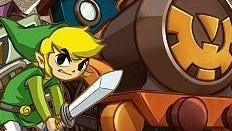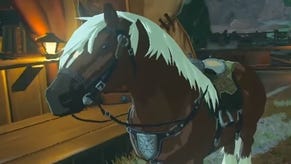The Legend of Zelda: Spirit Tracks
Toot sweet.
In gameplay terms, Zelda only comes into her own when she comes into someone else's. She can possess Phantoms, the invincible patrolling suits of armour in the Tower of Spirits, the 30-floor über-dungeon you need to return to and inch through in between each of the game's regular temples. It's a reprise of Phantom Hourglass's central Temple of the Ocean King, and also something of a Metal Gear tribute as Link sneaks around, avoiding the guards' gaze by diving into safe zones, while solving some of the game's trickier puzzles.
The Temple of the Ocean King's less popular features - its maddening time limit, and the need to start from the beginning on each visit (albeit with shortcuts) - have thankfully been ditched. You're even allowed to best Phantoms eventually, at which point Zelda can possess them and you can control her and Link simultaneously by drawing a path for her to follow, and pointing out things for her to interact with, with the stylus.
This is occasionally fiddly, but also exploited for some marvellous bifurcated puzzles and fights that contrast Link's agility with the Phantom suit's durability, as well as some cute role-reversal horseplay between the two romantic leads. There are even several variants of Phantom suit with clever powers. The Tower of Spirits still does odd things to the time-honoured pacing of a Zelda game - generally, the last thing you want to do when you step out of a temple is dive straight into another one - but it's a huge improvement on its predecessor, feels a lot less like filler, and supplies many of Spirit Tracks' standout moments.

The regular dungeons don't have such strong identities. Suspicions that Nintendo's designers are going through the motions somewhat aren't helped by the unprepossessing names (it's hardly a spoiler, I hope, to reveal that Wooded Temple is in Forest Land and Blizzard Temple in Snow Land) - and truth be told, beyond their rote elemental themes, they do blend into each other a bit. But that's partly because top-down Zelda dungeons have become so abstract over the last 23 years, which is precisely what allows them to be so densely packed with ideas. Un-knotting their secretly linear tangle of traps and riddles and boss fights is as satisfying and stimulating as it ever was, and in Spirit Tracks the difficulty is paced to absolute perfection. There are a few proper posers, but nothing completely obtuse, and that blissful Eureka moment always feels within your grasp.
It would be more of a spoiler than any plot revelation to tell you about the new toys for Link's toolbox of delights, since discovering these surreal Swiss Army weapons is a sacred moment for any Zelda fan. It's a mixed bag: one is a cute idea but a chore to use, one is rather limited in its application although it makes inspired use of the DS stylus, and one is a cracking instant classic that blends the utility of some old favourites with (the internet tells me) a tip of the hat to another, more obscure Nintendo series. I'll let you figure out which is which.





